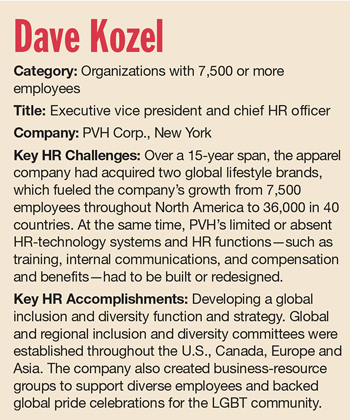This article accompanies This HR Executive of the Year is Transforming IBM.
Dave Kozel says the company he joined 15 years ago–PVH Corp.–bears little resemblance to the organization it is today. The clothing wholesaler and retailer grew from 7,500 employees in North America to 36,000 associates worldwide by acquiring global lifestyle brands that include Calvin Klein and Tommy Hilfiger.
In the early days, Kozel says, PVH’s HR function reflected a decades-old personnel department that focused on administrative transactions. Its HR systems were antiquated, and employee training was minimal. Even its internal communication strategy was practically null and void.
Since then, the HR and communication functions have evolved, reflecting a 21st-century workplace. Under Kozel’s guidance, a results-based HR function was built that values inclusion and diversity and supports a variety of communication tools such as an intranet. Hundreds of training opportunities exist for every employee at every level. HR also conducts employee surveys about staff needs and desired changes. Despite these massive improvements, Kozel says, he never considered himself an “HR person,” but rather he simply focused his energies on helping the company be successful.
Employees Rule
The catalyst behind most of these HR changes has been employee feedback from the company’s optional, biannual surveys, says Kozel, adding that the global response rate averages 86 percent. The results are disseminated to senior executives, who are mandated to share them with their department or staff and develop a global action plan to address each key issue.
One year, for example, employees cited a lack of skills training. So Kozel launched PVH University, which offers hundreds of face-to-face and online employee courses. The curriculum is organized into five academies aligned to support four key initiatives: leadership, inclusion and diversity, professional skills and supply chain. So far, 89 leaders have completed the global-leadership program within the leadership academy, which was designed in conjunction with the Wharton School of the University of Pennsylvania.
Since women represent 68 percent of PVH’s workforce, a women’s leadership council was also formed, which rotates its 10 members every two years and actively engages in women’s leadership issues, such as upward mobility.
Survey results even influenced the formation of Kozel’s talent acquisition and management team.
“This was a function that didn’t exist,” Kozel says, explaining that the HR team asked a series of questions in areas such as candidate search and assessment to better understand what was and wasn’t working. “We also needed to introduce a succession-planning process for executives. This was all part of building corporate functions.”
Five years ago, one of the issues employees raised was poor internal communication. Too important to place on a back burner, Kozel hired Tiffin Jernstedt to address the issue.
“Dave’s business acumen is incredible,” says Jernstedt, senior vice president of communications at PVH, who directly reports to Kozel. “He really takes the time to understand leaders in each department and really listens to what their business needs are, what they’re trying to accomplish or achieve. Then he puts his HR hat on next.”
While Kozel has coached her on the company’s “long game” of building critical employee programs, among Jernstedt’s favorite stories involves his commitment to employees, including the 200 associates who lived in Puerto Rico when Hurricane Maria slammed into the island last year. She says Kozel mobilized his HR team and company leaders to fundraise, ending up with $450,000 through employee donations and company-matching funds. PVH then partnered with charitable organization E4E to distribute the emergency funds to these employees, who were still receiving PVH paychecks even though their workplace was destroyed.
Due to Kozel and his HR team’s efforts, PVH has grabbed national attention.
In 2018, Forbes named PVH to its “America’s Best Employers for Diversity List.” The company also earned 100 percent on Human Rights Campaign’s Corporate Equality Index, which rates LGBT policies and programs, that same year. In 2017, it was ranked among the top 100 most inclusive and diverse employers globally on the Thomas Reuters Global Inclusion Index and named one of Forbes’ and Just Capital’s “Most JUST Companies.”
Just Doing My Job
The list of Kozel’s accomplishments goes on and on, which stems from his rich HR background. He earned a master’s degree in industrial relations from the University of Illinois and previously served as executive vice president of HR for J. Crew Group Inc., vice president of HR at Grey Advertising and Deluxe Electronic Payment Systems, and senior HR director at Citicorp Consumer Credit Services.
As an HR leader at PVH, he has encouraged senior leadership to participate in a training session–Confronting Unconscious Bias–and created two employee-retirement plans: a 401(k) and a fully funded, open-pension plan. For Kozel, diversity and inclusion aren’t part of a checklist; they have real meaning. For the past two years, the company has been a platinum-level sponsor for the New York City Pride March, which celebrates the LGBT community.
Still, Kozel says, his achievements are simply part of his job, or an evolutionary process he calls “continuous improvement.”
“I’ve always looked at myself as being responsible for human capital and ensuring that the workforce, the cost of the workforce, the complexion of the workforce, meets the needs of the businesses I’ve supported,” he says. “I’ve been able to do this successfully in many different industries, in many different ways, for many years.”

